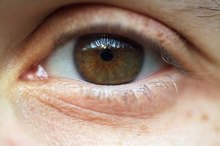Skin Discoloration on Kids
Skin discoloration in children manifests in several forms and has a number of possible causes. Discolorations include patches of redness, birthmarks or unexpected shifts in skin pigmentation. Skin discoloration can be the result of an injury, infection or imbalance in pigmentation-regulating substances in the body. Though most skin discoloration disorders pose cosmetic rather than medical concerns, children with skin discolorations should be examined by a doctor to rule out potentially serious health conditions such as a vitamin deficiency.
Causes
Children's skin discoloration is caused by several factors. Some discolorations are caused by a disease of an organ or body system; liver and kidney dysfunction can both lead to skin discoloration. If a child is on antibiotics for an infection or illness, skin discoloration or redness may appear as a side effect. Redness is often related to a localized irritation, but in children redness may also be a sign of a bacterial or viral infection that manifests as a rash or blotchy red patches. Poor blue circulation or a decreased efficiency in the circulation of oxygenated blood causes blue or gray skin. A gene mutation that triggers sections of the body to stop producing melanin, the chemical responsible for skin pigmentation, leads to whitened skin.
Identification
Infant Skin Discoloration
Learn More
Skin discoloration is marked by a distinction in skin pigmentation in a specific section of the body. Some skin discolorations like moles or birthmarks are notable for their darker pigmentation and specific shape and borders; many children are born with birthmarks that might fade over time. Other skin discolorations occur shortly after birth in the form of a rash on the face, neck or head. In older children, differentiation in pigmentation in the form of either large dark patches or large bleaches patches of skin signal a skin discoloration disorder.
Types
In infants, the most common skin discolorations are rashes or redness. Erythema toxicum, or newborn rash, is a common rash that appears within five days after birth in as many as fifty percent of newborns; the harmless red patches dotted with small white bumps are harmless and non contagious. Eczema is common rash disorder that leaves scaly, itchy patches of red skin on a baby's head, arms or legs. Jaundice is another common infant skin disorder that is caused by insufficient breakdown of bilirubin in the blood; the yellow skin condition is often indicative of a problem with the liver functioning.
Older children may develop impetigo, a contagious bacterial infection that causes red patches and blisters to spread around the infected area. If a child begins losing normal skin pigmentation and displaying bright white patches in the chest, back or arms, it is likely due to a gene mutation that causes a disorder called vitiligo; vitiligo that develops during childhood tends to be more severe and pervasive than development during adulthood. Whitening skin may also be a sign of albinism, a much rarer condition.
Considerations
Difference Between Physiological & Pathological Jaundice
Learn More
Skin discolorations in children arise from a wide variety of causes and some disorders may be more serious than others. For instance, jaundice may be the sign of a serious problem in liver functioning or it may indicate a simple Vitamin D deficiency. Patches of redness caused from infant rashes are common but may also indicate a serious infection like hand, foot and mouth disease. Though most discolorations are temporary or purely cosmetic, a doctor is the only person who can properly diagnose and treat a skin discoloration disorder.
Prevention/Solution
Most children will develop some form of rash or discoloration during their childhood. Infants are especially susceptible to rashes due to their young immune system. Most rashes like eczema respond to simple treatments like diluted bleach solution baths. Bacterial infections are treated with antibiotic ointments or oral medications.
Skin conditions that are due to other disorders in the body such as improper liver function are treated by addressing the source of the disorder. In severe cases, liver biopsies are taken to determine the functional capabilities of the organ.
More dramatic skin discolorations caused by vitiligo or albinism are more difficult to treat. Vitiligo cannot be cured, but creams and ointments applied to the affected area prevent the spread of the discoloration and protect vulnerable patches of pale skin. Some creams called immunomodular creams have been effective in returning the affect skin areas to their normal pigmentation, but doctors question the safety of the cream on very young children.
Related Articles
References
Writer Bio
Hannah Wahlig began writing and editing professionally in 2001. Her experience includes copy for newspapers, journals and magazines, as well as book editing. She is also a certified lactation counselor. She holds a Bachelor of Arts in English from Mount Holyoke College, and Master's degrees in education and community psychology from the University of Massachusetts.









